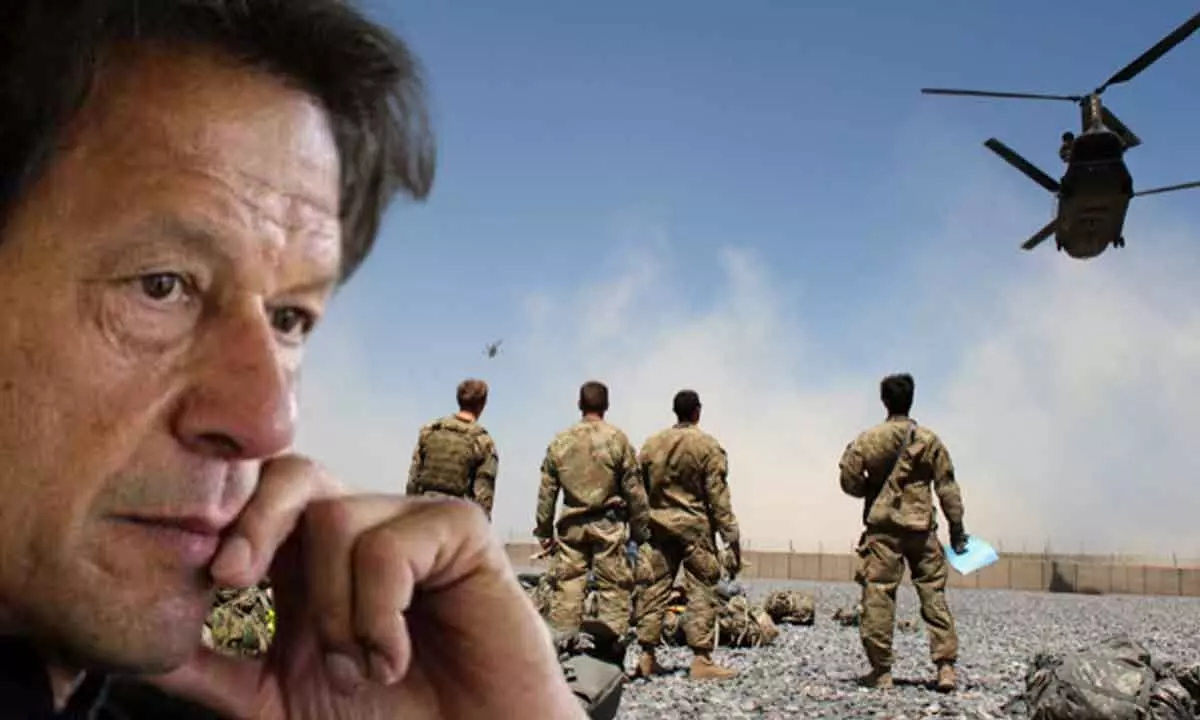Imran Khan’s survival in jeopardy as military-establishment draws battlelines
The chances of the current crisis cooling down are bleak as it has become a clash of individuals - Imran Khan Vs General Munir
image for illustrative purpose

One thing is clear the ongoing crisis had led to the polarisation of the Pakistani ruling elite into two opposing fractions. So the two groups in military parlance are- the red forces headed by Shehbaz Sharif, President of Pakistan Muslim League (N), backed by General Asim Munir, Chief of army staff, and the blue forces led by Imran Khan, who in turn is supported by the Judiciary
The battlelines are drawn between the former Pakistan Prime Minister and Pakistan Tehreek-e-Insaf (PTI) chairman Imran Khan and the Pak establishment, and it seems both are going to fight to finish.
Attacks on military real or engineered
Khan, the former cricket-turned-politician, was arrested on May 9, when he appeared for a hearing at the Islamabad High Court (IHC), and it triggered violent protests nationwide, including attacks on armed forces locations and facilities. Many Pak watchers and commentators acknowledge that such direct anger against the Pak establishment was last seen in 1970 when President General Yahya Khan denied Mujibur Rahman’s party the opportunity to form the government. The Awami League called for a non-cooperation movement, and it resulted in violence against the Pakistani forces stationed in East Pakistan (now Bangladesh). While Prime Minister Shehbaz Sharif, head of the ruling coalition government, blamed Imran and his supporters for torching the Corps Commander House in Lahore. A counter-narrative also suggests that attacks on various army locations were engineered to discredit and ban PTI and Imran Khan.
Split among Pak ruling elite
One thing is clear the ongoing crisis had led to the polarisation of the Pakistani ruling elite into two opposing fractions. So the two groups in military parlance are- the red forces headed by Shehbaz Sharif, President of Pakistan Muslim League (N), backed by General Asim Munir, Chief of army staff, and the blue forces led by Imran Khan, who in turn is supported by the Judiciary. Since 1997 the Pak Judges have grown in power - as a result, the Supreme Court has ousted two Prime Ministers from office: Nawaz Sharif and Yousaf Raza Gillani. Even former President and Army chief General Pervez Musharraf suffered humiliation at the hands of Pakistan's Judiciary. It is important to note that the standoff between Musharraf and the Judiciary played a significant role in shaping Pakistan's political landscape and contributed to the discourse on the rule of law and judicial independence in the country. Since then Judiciary has emerged as a powerful factor in Pakistan's power equation.
Clash of Egos
The chances of the current crisis cooling down are bleak as it has become a clash of individuals - Imran Khan Vs General Munir. The Pak COAS has a 50-plus years legacy to uphold, wherein Army chiefs have been the law. Thus, his bowing down to Khan - once a military puppet and non-Punjabi, is out of the question. Similarly, Khan has harboured the bitterness of being sacked, and the recent arrest and thrashing by Rangers have added insult to injury.
Tribal Honour
Khan belongs to the Niazi Pashtun tribe, which had settled in the Mianwali area of northwestern Punjab. Global Security, a US-based think tank, in its analysis of the concept of 'Badal – revenge’ among Pashtuns, says - "It is closely related to the notion of honour." Thus, offences to one's honour must be avenged, or there is no honour. As one Pashtun proverb goes, "I took my revenge after a hundred years, and I only regret that I acted in haste." Badal is the most important, dominant and greatest of all Pathan traits. All those who have seen the Hollywood movie -Rambo III - will recall the famous line by Colonel Trautman, a character played by Richard Crenna- "God would have mercy. He won't." Well, that must be the apprehension among Pakistan's establishment, so they are devising newer ways to entangle him and keep him in crisis mode.
Unleashing 5th Gen Warfare
After securing bail, Khan, the 70-year-old PTI party chief, was pinned down in the court premises for many hours. While his legal team was locked in apparent negotiations with authorities - there were also reports of firing incidents outside Islamabad High Court as Khan awaited his safe passage. Further, a picture of Imran Khan looking frustrated and disappointed was released, which was made by using an Artificial intelligence (AI) tool. The Pak establishment unleashed 5th Gen warfare in the form of psyops, AI and 'misinformation' to break Khan and his supporters. And, to their credit - the Pak army managed to throw Imran off balance. This was evident in Khan's post-release address from his now-famous Lahore's Zaman Park residence to his followers. While directing his anger and frustration toward General Munir, a shaken PTI chief who seemed not in control, uttered the 'C- word', a derogatory Urdu term, on live TV.
What’s next for Pakistan?
The Pakistani political pot hasn't reached the perfect boiling point for now. Khan and General Munir will continue to plan and execute moves and countermoves against each other. The jury is still out on - how deep are the fissures between and within the ruling elite and the Pak establishment. Unverified audio tapes claim a split within the mighty Pak military too. Thus - the question is - Is Khan resentful enough to do Mujibur Rahman on Pakistan, leading to another division of the country? But, most importantly, will the fissures within Pakistan's establishment deepen further in the coming time?
(The author is Founder of My Startup TV)

